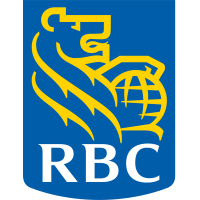- Chart
- Upturn Summary
- Highlights
- Valuation
 Upturn AI SWOT
Upturn AI SWOT - About
Royal Bank of Canada (RY)

- BUY Advisory
- SELL Advisory (Profit)
- SELL Advisory (Loss)
- Profit
- Loss
- Pass (Skip investing)
 Stock price based on last close
Stock price based on last close (see disclosures)
- ALL
- 1Y
- 1M
- 1W
Upturn Advisory Summary
11/24/2025: RY (4-star) is a STRONG-BUY. BUY since 24 days. Simulated Profits (2.75%). Updated daily EoD!
1 Year Target Price $145.61
1 Year Target Price $145.61
| 8 | Strong Buy |
| 5 | Buy |
| 3 | Hold |
| 0 | Sell |
| 0 | Strong Sell |
Analysis of Past Performance
Type Stock | Historic Profit 58.1% | Avg. Invested days 70 | Today’s Advisory Strong Buy |
Upturn Star Rating  | Upturn Advisory Performance | Stock Returns Performance |
Key Highlights
Company Size Large-Cap Stock | Market Capitalization 211.14B USD | Price to earnings Ratio 15.98 | 1Y Target Price 145.61 |
Price to earnings Ratio 15.98 | 1Y Target Price 145.61 | ||
Volume (30-day avg) 16 | Beta 1.01 | 52 Weeks Range 103.51 - 150.84 | Updated Date 11/24/2025 |
52 Weeks Range 103.51 - 150.84 | Updated Date 11/24/2025 | ||
Dividends yield (FY) 3.95% | Basic EPS (TTM) 9.37 |
Analyzing Revenue: Products, Geography and Growth
Revenue by Geography
Geography revenue - Year on Year
Earnings Date
Report Date - | When - | Estimate - | Actual - |
Profitability
Profit Margin 31.77% | Operating Margin (TTM) 45.38% |
Management Effectiveness
Return on Assets (TTM) 0.89% | Return on Equity (TTM) 14.73% |
Valuation
Trailing PE 15.98 | Forward PE 13.79 | Enterprise Value -69870919680 | Price to Sales(TTM) 3.5 |
Enterprise Value -69870919680 | Price to Sales(TTM) 3.5 | ||
Enterprise Value to Revenue 12.94 | Enterprise Value to EBITDA - | Shares Outstanding 1410306580 | Shares Floating 1403739717 |
Shares Outstanding 1410306580 | Shares Floating 1403739717 | ||
Percent Insiders 0.04 | Percent Institutions 49.05 |
 Upturn AI SWOT
Upturn AI SWOT
Royal Bank of Canada

Company Overview
 History and Background
History and Background
Royal Bank of Canada (RBC) was founded in 1864 in Halifax, Nova Scotia, as the Merchants Bank of Halifax. It initially financed the fishing and timber industries. It expanded across Canada and internationally, becoming the Royal Bank of Canada in 1901. Over the years, it has grown through acquisitions and organic growth, becoming one of the largest banks in North America.
 Core Business Areas
Core Business Areas
- Personal & Commercial Banking: Provides a wide array of financial products and services, including deposit accounts, loans, mortgages, and credit cards, to individual clients and small businesses.
- Wealth Management: Offers investment management, financial planning, and trust services to high-net-worth individuals, families, and institutions.
- Capital Markets: Provides investment banking, corporate banking, and global markets services to corporations, institutional investors, and governments.
- Insurance: Offers a range of insurance products, including life, health, home, and auto insurance, to individuals and businesses.
 Leadership and Structure
Leadership and Structure
RBC is led by a Chief Executive Officer (CEO) and a senior management team. The company has a Board of Directors that oversees the management and strategic direction of the organization. The organizational structure is segmented by business lines and corporate functions.
Top Products and Market Share
 Key Offerings
Key Offerings
- Competitors: TD,BMO,BNS
- Residential Mortgages: RBC is one of the largest mortgage lenders in Canada, holding a significant market share. Competitors include TD Bank, Scotiabank, and BMO. Market share information is based on internal estimates and public reports. Exact numbers are difficult to determine as they are not always released on a product-specific level. According to the 2023 Statista report, Royal Bank of Canada and Toronto-Dominion Bank are the top 2 Canadian banks that hold the largest residential mortgages, each with $327 billion and $325 billion respectively.
- Competitors: COF,AXP,JPM
- Credit Cards: RBC offers a variety of credit cards, including rewards cards, travel cards, and low-interest cards. They compete with other major banks and credit card issuers. Number of users and revenue are confidential, but it generates significant revenue for the bank. Competitors include Capital One, American Express, and Chase.
- Competitors: GS,MS,JPM
- Investment Banking: RBC Capital Markets provides advisory services for M&A transactions, underwriting, and trading. It competes with global investment banks such as Goldman Sachs, Morgan Stanley, and JP Morgan Chase. Revenue figures are difficult to access as they are grouped with Capital Markets
Market Dynamics
 Industry Overview
Industry Overview
The financial services industry is currently undergoing significant digital transformation, increasing competition from fintech companies, and evolving regulatory landscape. Interest rate fluctuations and economic conditions significantly impact profitability.
Positioning
RBC is a leading player in the Canadian financial services market, known for its strong brand, diversified business lines, and large customer base. Its competitive advantages include a strong capital position and a wide range of products and services.
Total Addressable Market (TAM)
The global financial services market is estimated at approximately $26.5 trillion in 2023 and is projected to reach $33.5 trillion by 2028. RBC, with its strong presence in North America, is well-positioned to capture a significant portion of this market.
Upturn SWOT Analysis
Strengths
- Strong brand recognition
- Diversified business lines
- Large customer base
- Strong capital position
- Advanced technology infrastructure
Weaknesses
- High operating costs
- Dependence on the Canadian market
- Exposure to regulatory risks
- Potential for reputational damage
Opportunities
- Expansion into new markets
- Growth in wealth management
- Increased adoption of digital banking
- Strategic acquisitions
- Growing Demand for Insurance Products
Threats
- Increased competition from fintech companies
- Economic downturns
- Rising interest rates
- Cybersecurity threats
- Changes in regulations
Competitors and Market Share
 Key Competitors
Key Competitors
- TD
- BNS
- BMO
- CM
Competitive Landscape
RBC has a strong competitive position due to its size, brand, and diversified business lines. It faces competition from other large Canadian banks, as well as global financial institutions.
Major Acquisitions
Brewin Dolphin
- Year: 2022
- Acquisition Price (USD millions): 2.6
- Strategic Rationale: Expand wealth management business in the UK and Ireland.
Growth Trajectory and Initiatives
Historical Growth: RBC has experienced steady growth over the past years, driven by organic growth, acquisitions, and expansion into new markets.
Future Projections: Analysts project continued growth for RBC, driven by its diversified business lines, strong capital position, and strategic initiatives. (Future figures vary depending on the analyst)
Recent Initiatives: Recent initiatives include investments in digital banking, expansion into new markets, and strategic acquisitions.
Summary
Royal Bank of Canada is a strong financial institution with a diversified business model and a leading position in the Canadian market. Its strengths include a strong brand, a large customer base, and a solid capital position. However, it faces challenges from increased competition from fintech companies and economic uncertainties. RBC needs to continue to invest in technology and innovation to maintain its competitive edge and expand into new markets to drive future growth.
Similar Stocks
Sources and Disclaimers
Data Sources:
- Company filings
- Financial news outlets
- Analyst reports
- Statista
Disclaimers:
The information provided is for informational purposes only and does not constitute financial advice. Investment decisions should be based on thorough research and consultation with a qualified financial advisor. Market share data and financial metrics may vary depending on the source and time period.
 AI Summarization is directionally correct and might not be accurate.
AI Summarization is directionally correct and might not be accurate.
 Summarized information shown could be a few years old and not current.
Summarized information shown could be a few years old and not current.
 Fundamental Rating based on AI could be based on old data.
Fundamental Rating based on AI could be based on old data.
 AI-generated summaries may have inaccuracies (hallucinations). Please verify the information before taking action.
AI-generated summaries may have inaccuracies (hallucinations). Please verify the information before taking action.
About Royal Bank of Canada
Exchange NYSE | Headquaters Toronto, ON, Canada | ||
IPO Launch date 1995-10-16 | President, CEO & Director Mr. David I. McKay | ||
Sector Financial Services | Industry Banks - Diversified | Full time employees 97116 | Website https://www.rbc.com |
Full time employees 97116 | Website https://www.rbc.com | ||
Royal Bank of Canada operates as a diversified financial service company worldwide. Its Personal Banking segment offers home equity financing, personal lending, chequing and savings accounts, private banking, auto financing, mutual funds, GICs, credit cards, and payment products and solutions. The company's Commercial Banking segments provides lending, deposit and transaction banking products and services. Its Wealth Management segment provides a suite of wealth, investment, trust, banking, credit, and other solutions to clients; asset management products to institutional and individual clients; and asset and investor services to financial institutions, asset managers, and asset owners. The company's Insurance segment offers life, health, travel, wealth, annuities, property and casualty, and reinsurance advice and solutions; digital platforms; and independent brokers and partners, as well as client-led advice and solutions. The company's Capital Markets segment offers advisory and origination, sales and trading, lending and financing, and transaction banking services to corporations, institutional clients, asset managers, private equity firms, and governments. The company was founded in 1864 and is headquartered in Toronto, Canada.

Note: This website is maintained by Upturn Corporation, which is an investment adviser registered with the U.S. Securities and Exchange Commission. Such registration does not imply a certain level of skill or training. Investing in securities has risks. Past performance is no guarantee of future returns. No assurance is provided as to any particular investment return, and you may lose money using our services. You are strongly advised to consult appropriate counsel before making any investments in companies you learn about through our services. You should obtain appropriate legal, tax, investment, accounting, and other advice that takes into account your investment portfolio and overall financial situation. You are solely responsible for conducting due diligence on a potential investment. We do not affect trades for you. You will select your own broker through which to transact. Investments are not FDIC insured, they are not guaranteed, and they may lose value. Please see the Privacy Policy, Terms of Use, and Disclosure for more information.
 Home
Home 
